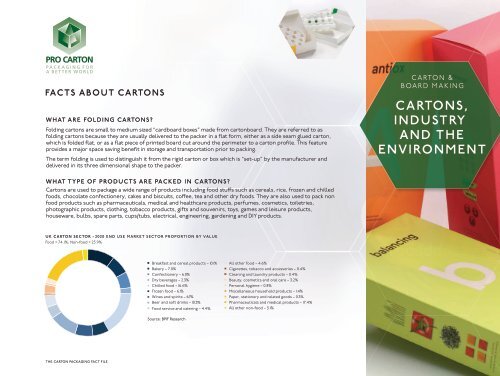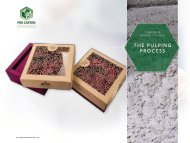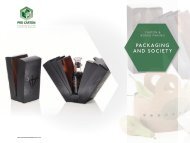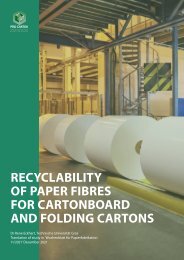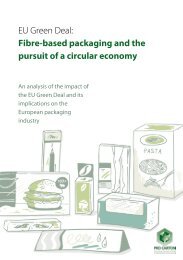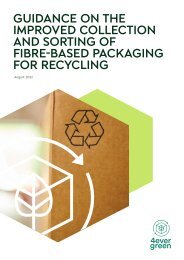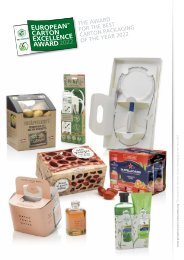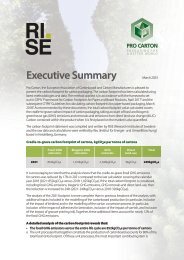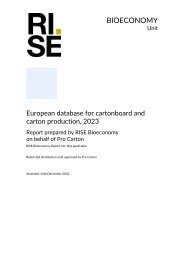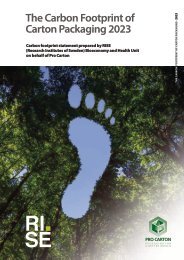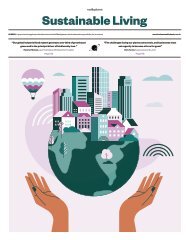Pro Carton Fact File – Module 2 – Cartons, Industry and the Environment
Create successful ePaper yourself
Turn your PDF publications into a flip-book with our unique Google optimized e-Paper software.
FACTS ABOUT CARTONS<br />
WHAT ARE FOLDING CARTONS?<br />
Folding cartons are small to medium sized “cardboard boxes” made from cartonboard. They are referred to as<br />
folding cartons because <strong>the</strong>y are usually delivered to <strong>the</strong> packer in a flat form, ei<strong>the</strong>r as a side seam glued carton,<br />
which is folded flat, or as a flat piece of printed board cut around <strong>the</strong> perimeter to a carton profile. This feature<br />
provides a major space saving benefit in storage <strong>and</strong> transportation prior to packing.<br />
CARTON &<br />
BOARD MAKING<br />
CARTONS,<br />
INDUSTRY<br />
AND THE<br />
ENVIRONMENT<br />
The term folding is used to distinguish it from <strong>the</strong> rigid carton or box which is “set-up” by <strong>the</strong> manufacturer <strong>and</strong><br />
delivered in its three dimensional shape to <strong>the</strong> packer.<br />
WHAT TYPE OF PRODUCTS ARE PACKED IN CARTONS?<br />
<strong>Carton</strong>s are used to package a wide range of products including food stuffs such as cereals, rice, frozen <strong>and</strong> chilled<br />
foods, chocolate confectionery, cakes <strong>and</strong> biscuits, coffee, tea <strong>and</strong> o<strong>the</strong>r dry foods. They are also used to pack non<br />
food products such as pharmaceuticals, medical <strong>and</strong> healthcare products, perfumes, cosmetics, toiletries,<br />
photographic products, clothing, tobacco products, gifts <strong>and</strong> souvenirs, toys, games <strong>and</strong> leisure products,<br />
houseware, bulbs, spare parts, cups/tubs, electrical, engineering, gardening <strong>and</strong> DIY products.<br />
U K CARTO N S ECTO R - 2020 END USE MARKET SECTOR PROPORTION BY VALUE<br />
Food = 74.1%; Non-food = 25.9%<br />
Breakfast <strong>and</strong> cereal products <strong>–</strong> 10.1%<br />
Bakery <strong>–</strong> 7.0%<br />
Confectionery <strong>–</strong> 6.0%<br />
Dry beverages <strong>–</strong> 2.3%<br />
Chilled food <strong>–</strong> 16.6%<br />
Frozen food <strong>–</strong> 6.1%<br />
Wines <strong>and</strong> spirits <strong>–</strong> 6.7%<br />
Beer <strong>and</strong> soft drinks <strong>–</strong> 10.3%<br />
Food service <strong>and</strong> catering <strong>–</strong> 4.4%<br />
All o<strong>the</strong>r food <strong>–</strong> 4.6%<br />
Cigarettes, tobacco <strong>and</strong> accessories <strong>–</strong> 0.4%<br />
Cleaning <strong>and</strong> laundry products <strong>–</strong> 0.4%<br />
Beauty, cosmetics <strong>and</strong> oral care <strong>–</strong> 3.2%<br />
Personal hygiene <strong>–</strong> 0.8%<br />
Miscellaneous household products <strong>–</strong> 1.4%<br />
Paper, stationery <strong>and</strong> related goods <strong>–</strong> 0.3%<br />
Pharmaceuticals <strong>and</strong> medical products <strong>–</strong> 17.4%<br />
All o<strong>the</strong>r non-food <strong>–</strong> 3.1%<br />
Source: BPIF Research<br />
THE CARTON PACKAGING FACT FILE<br />
All contents copyright © BPIF 2017.


